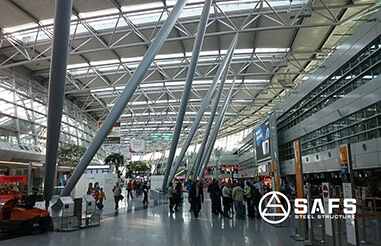Dapeng Town Industrial Park, Tongshan District, Xuzhou City, Jiangsu Province, China
The roof steel structure of the Beijing New Airport Terminal Building has become the focus and difficulty of the seismic design of the project due to its large volume, complex shape, large span, small number of supporting components and the presence of special-shaped columns. The roof area on the north side of the central hall is large, and there is a large cantilever. The center of mass of the overall structure is biased to the north, while the roof elevation is high on the north side and low on the south side. The curtain wall columns and C-shaped columns supporting the roof on the north side are relatively high, and the lateral stiffness is relatively small. The center of rigidity of the overall structure is biased to the south, which will cause the steel structure to twist. By adjusting the supporting structure layout, increasing the stiffness of the roof supporting structure on the north side while reducing the stiffness of the roof supporting structure on the south side, the deviation between the center of mass and the center of rigidity of the structure is effectively reduced, the torsional stiffness of the structure is improved, and the torsional effect of the structure is reduced. The steel structure of the central hall roof is composed of six main structural units connected by the central skylight dome and six central radiating skylight strips. The skylight dome and skylight strip structures are relatively light truss structures with thin structure thickness. Compared with the six main grid structures, they are relatively weak parts of the overall structure. Once the skylight dome and skylight strip structures fail, the overall structure becomes six independent structural units. Each structural unit independently bears its own regional load, which is quite different from the overall stress state. The bearing capacity of steel components under non-seismic combination and fortification intensity earthquake combination is verified for the structural block model. The results show that even if the central skylight dome and six skylight strip structures fail, the main steel structure still has sufficient bearing capacity and will not collapse.

Due to the large difference in lateral stiffness of various roof supporting structural components such as C-shaped columns, steel support tubes, north curtain wall support frames, independent steel pipe columns and other curtain wall columns, in order to improve the safety of the overall structure under earthquake action, a multi-line defense analysis under earthquake action is carried out. Considering that the roof steel structure of this project is a large-span spatial structure, it is reasonable that the roof supporting components can bear the seismic action generated by their own load mass. The ratio of gravity load and seismic shear force borne by each roof supporting component is analyzed. For the roof supporting components whose seismic shear force ratio is less than their gravity load ratio, their seismic shear force is adjusted according to the gravity load ratio to improve the multi-line seismic resistance of the overall structure.
By establishing a dynamic elastoplastic time-history analysis model of the central hall structure, a dynamic elastoplastic time-history analysis under rare earthquakes is carried out, focusing on the plastic deformation and development degree of the roof supporting steel structure and concrete structure. The results show that although some components enter the elastoplastic working state and the strength and stiffness degradation occur, the degree of degradation is not large. The overall structure has sufficient capacity to redistribute internal forces to maintain its overall stability and withstand earthquake action and gravity load.